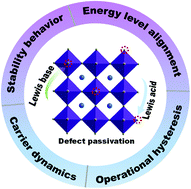Lewis acid/base approach for efficacious defect passivation in perovskite solar cells
Abstract
Halide perovskite solar cells (PSCs) have been materialized as a hotspot in the next-generation photovoltaic technology due to their low-cost manufacturing process and high-efficiency characteristics. However, the defects within the bulk or in the grain boundaries and surface hinder ambipolar charge transport as non-radiative recombination centers. Efficacious defect passivation is therefore highly desired for high-efficiency and stable PSCs. Herein, a feasible Lewis acid/base passivation strategy and its effects on energy level alignment, recombination kinetics, hysteresis behavior and operational stability for efficient PSCs are comprehensively reviewed. These additives have been widely used to coordinate with unwanted defects and form Lewis adducts by dative bonds, where the Lewis acid contributes to passivate negatively charged defects (e.g., under-coordinated I− ions and Pb–I anti-sites) and the Lewis base plays a significant role in passivating positively charged defects (e.g., under-coordinated Pb2+ and Pb2+ interstitials), whereas zwitterions could passivate negatively and positively charged defects simultaneously. This highly executable Lewis adduct passivation would enable scalable deposition techniques for efficient and stable PSCs like inkjet printing, doctor-blade coating, screen printing, laser pattering and roll-to-roll deposition. Additionally, we also discuss the prospects of the maturity of this passivation strategy towards upscaling manufacture of perovskite photovoltaic and related optoelectronic devices.



 Please wait while we load your content...
Please wait while we load your content...